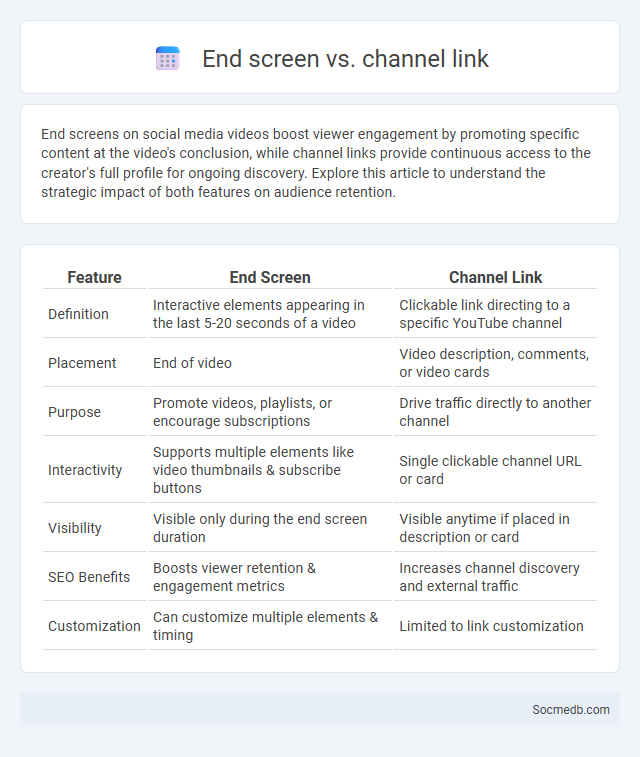
Photo illustration: End screen vs Channel link
End screens on social media videos boost viewer engagement by promoting specific content at the video's conclusion, while channel links provide continuous access to the creator's full profile for ongoing discovery. Explore this article to understand the strategic impact of both features on audience retention.
Table of Comparison
| Feature | End Screen | Channel Link |
|---|---|---|
| Definition | Interactive elements appearing in the last 5-20 seconds of a video | Clickable link directing to a specific YouTube channel |
| Placement | End of video | Video description, comments, or video cards |
| Purpose | Promote videos, playlists, or encourage subscriptions | Drive traffic directly to another channel |
| Interactivity | Supports multiple elements like video thumbnails & subscribe buttons | Single clickable channel URL or card |
| Visibility | Visible only during the end screen duration | Visible anytime if placed in description or card |
| SEO Benefits | Boosts viewer retention & engagement metrics | Increases channel discovery and external traffic |
| Customization | Can customize multiple elements & timing | Limited to link customization |
Understanding YouTube End Screens
YouTube End Screens are interactive elements placed in the last 5-20 seconds of a video, designed to boost viewer engagement by promoting other videos, playlists, or channels. Properly optimized end screens can significantly increase watch time and subscriber growth by guiding viewers to additional content and encouraging actions such as subscribing or visiting an external website. Understanding YouTube's End Screen policies and best practices ensures creators maximize the impact of these features while maintaining compliance with platform guidelines.
What Are Channel Links on YouTube?
Channel links on YouTube are unique URLs that direct users to a specific creator's channel, enabling easier access to videos and content. These links typically follow a standardized format, such as youtube.com/channel/ followed by the channel ID or youtube.com/c/ with a custom name. Utilizing channel links enhances viewer engagement by simplifying the process of subscribing and exploring a creator's entire library.
Key Benefits of Using End Screens
End screens on social media videos boost viewer engagement by promoting additional content, increasing watch time, and encouraging subscriptions. They provide customizable options to showcase playlists, external links, and channel branding, enhancing user experience. Leveraging end screens effectively drives audience retention and supports channel growth across platforms like YouTube.
Channel Link Advantages for Creators
Channel links streamline audience access by consolidating multiple social media profiles into a single, easy-to-share URL, boosting creator visibility and engagement. This centralized link facilitates cross-platform promotion, increasing follower growth and improving content discoverability. Enhanced analytics from channel link services enable creators to optimize marketing strategies and tailor content to audience preferences, driving higher conversion rates.
End Screen vs Channel Link: Major Differences
End Screen elements on social media platforms are interactive features that appear during the last 5-20 seconds of a video, designed to boost viewer engagement by showcasing specific content such as playlists, videos, or subscription prompts. Channel Links, on the other hand, are static or clickable links that direct users to an entire channel or external profiles, providing broader navigation rather than targeted content promotion. Understanding these major differences helps you strategically use End Screens for immediate action and Channel Links for long-term audience growth.
When to Use End Screens on Your Videos
End screens should be used during the last 5 to 20 seconds of your videos to maximize viewer engagement and guide them to take desired actions such as subscribing, watching more content, or visiting a website. Incorporating end screens is particularly effective on educational and tutorial videos where viewers are likely to seek further related content or resources. Optimizing end screen timing and placement increases click-through rates and enhances overall channel growth by retaining viewer attention until the video's conclusion.
Optimal Situations for Channel Links
Optimal situations for channel links on social media include collaborations with influencers, brand partnerships, and targeted advertising campaigns. Your content performs best when channel links are strategically placed in high-traffic locations like bio sections, stories, and pinned posts. Leveraging these touchpoints maximizes reach, engagement, and conversion rates effectively.
Combining End Screens and Channel Links for Growth
Combining end screens and channel links strategically enhances audience retention and drives targeted traffic to key content, boosting channel growth on platforms like YouTube. These tools create seamless navigation, encouraging viewers to explore related videos or subscribe, which increases watch time and subscriber count. Optimizing placement and design of end screens alongside customized channel links maximizes viewer engagement and conversion rates for sustained social media growth.
Best Practices for Maximizing Engagement
Maximizing engagement on social media requires creating high-quality, relevant content tailored to your target audience's interests and behaviors. You should consistently use eye-catching visuals and compelling calls-to-action to encourage interaction, while actively responding to comments and messages to foster community. Leveraging analytics tools to track performance metrics helps refine strategies and identify the best times for posting to boost visibility and engagement rates.
Final Thoughts: Choosing the Right Strategy
Selecting the right social media strategy hinges on aligning your goals with the platforms that best reach your target audience. Analyze engagement metrics and audience demographics to tailor content that maximizes reach and impact. Your success depends on consistently measuring performance and adapting tactics to stay relevant in an ever-evolving digital landscape.
 socmedb.com
socmedb.com